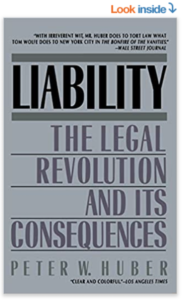Stoa Notes: Reforming Tort Law
Resolved: Tort law should be substantially reformed in the United States.
Cato, Heritage, AIER, AEI, and other market-oriented think tanks and education organization have resources worth reviewing on tort law reform:
• Liability Protections Are Critical to Ensuring Economic Recovery (Heritage Foundation, May 4, 2020)
• Tort Reform and Innovation (Cato Institute, February 7, 2018)
• Entrepreneurship: A Fading Virtue (AIER, March 25, 2021)
• We need to protect reopened businesses from a lawsuit pandemic (AEI, May 8, 2020)
• Steve Horwitz: 8 steps to reform health care, lower costs, improve quality and increase access (AEI Ideas, June 29, 2017)
• Dos and Don’ts of Tort Reform (FEE, May 1, 2005)
• Tort Liability Protection (State Policy Network)
• Trial Lawyers, Inc.: Think Globally, Sue Locally (Manhattan Institute, February 17, 2021)
• Medical Malpractice Reform: Ten Principles of a Rational Tort System (Independent Institute, November 26, 2012)
• Judge and Jury: American Tort Law on Trial (Independent Institute book, 2006)
• Firearms Litigation: Liability, Regulation, and the Constitution (Volokh Conspiracy (“Mostly law professors | Sometimes contrarian | Often libertarian | Always independent | Est. 2002”), November 30, 2020)
• Frivolous Litigators Bite the Hands That Care for Them (Reason, April 16, 2020)
• Litigation reform moving fast through House of Representatives (Overlawyered, March 8, 2017). Overlawyered has many posts on tort reform.
• COVID-19 Liability: Tort, Workplace Safety, and Securities Law (Congressional Research Service, September 24, 2020).
Nutritional Interventions, Federal Guidelines, and Litigation Fears
Further tort related challenges follow from fears of medical malpractice litigation. Doctors who follow the best science fear being sued for prescribing nutritional intervention (or therapy) for diabetes, obesity, cardiovascular disease (each a result of decades of metabolic syndrome/insulin resistance). Federal dietary guidelines still resist or ignore dozens of studies finding that reduced carbohydrates reverse (or put into remission) diabetes, often within just a few weeks.
See, for example, 2020-2025 Dietary Guidelines Not Applicable for Majority of Americans; Not Scoped for 60% Of U.S. With at Least One Diet-Related Chronic Disease (Nutrition Coalition, December 29, 2020):
For 40 years now, the Dietary Guidelines have been more than just recommendations. They are arguably the single-most powerful lever influencing what Americans eat, a broadly influential policy that is considered the ‘gold standard,’ followed by most healthcare practitioners, K-12 educators, media outlets, and the military. The DGA also drives food choices for the $100 billion spent by the USDA on Nutrition Assistance Programs, for school lunches, feeding assistance for the elderly and women with infant children, food for disadvantaged communities, and more.
Current tort law and litigation fears lead doctors to avoid recommending that patients reduce carbohydrates. Most doctors continue to prescribe often expensive medications for diabetes and other chronic conditions caused by metabolic disease. Nutritional “intervention” would be a more effective therapy, but is for now risky for doctors and health care companies.
For research on benefits, see: When COVID-19 Shrinks Away, Our Obesity and Diabetes Epidemic Will Still be Growing (Nicholas Norwitz, Society of Metabolic Health Practitioners, April 20, 2021)
Additional resources (and training) regarding the health benefits of nutritional interventions for chronic conditions, I recommend the website and podcasts of the Society for Metabolic Health Practitioners.

On tort law reform, highly recommended is Peter Huber’s classic Liability: The Legal Revolution and Its Consequences (1990). Link to Amazon where “Look Inside” is available.
Review of Peter W. Huber, Liability: The Legal Revolution and Its Consequences:
Abstract: Legal costs are now a major factor for U.S. firms to consider when marketing products and services. For example, they represent 95% of the price of childhood vaccines. Product liability is so important that many useful products, such as the IUD for birth control, have been removed from the market. Certain services, such as day care centers, are provided at high prices to cover liability exposure. Why have legal costs associated with products risen so rapidly since the early 1960s?
So… for debaters much interesting and important ground to cover for the tort reform topic…
